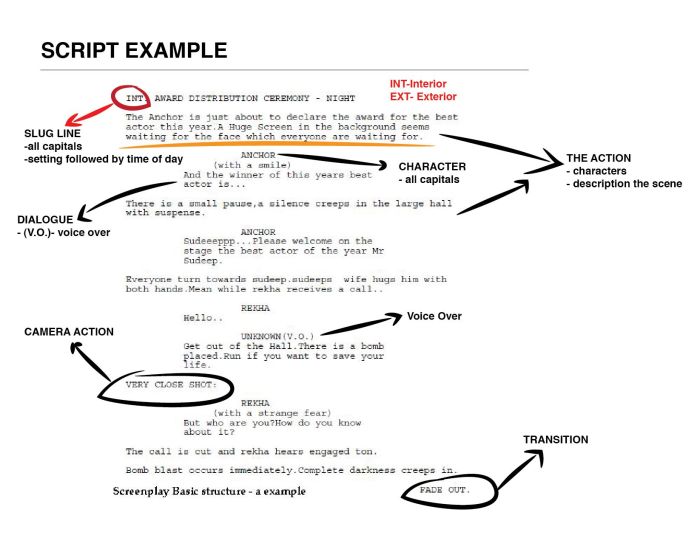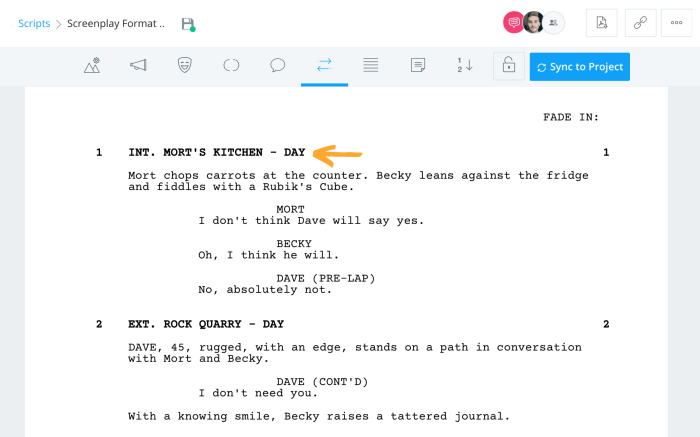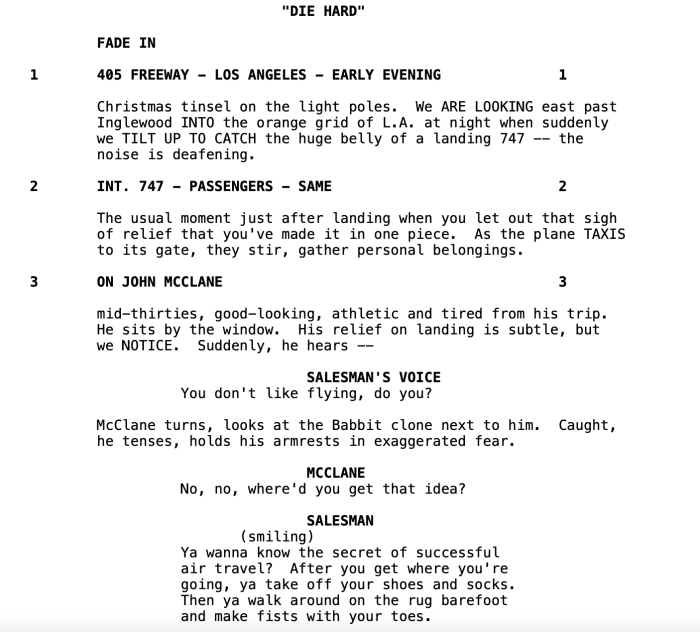Ever dreamed of seeing your story on the big screen? Maybe you’ve got a killer idea for a movie, but you’re not sure where to start. Don’t worry, you’re not alone! This guide will walk you through the exciting world of screenwriting, giving you the tools and knowledge you need to bring your cinematic vision to life.
From understanding the basics of screenplay structure to crafting compelling characters and dialogue, this guide covers all the essential elements of writing a movie. We’ll explore how to create a captivating logline, develop a strong three-act structure, and learn the secrets of writing dialogue that pops off the page.
Plus, we’ll dive into the formatting conventions and organizational structure that every screenwriter needs to know.
Writing Dialogue and Characters

Dialogue is the lifeblood of a screenplay. It’s what brings your characters to life, moves the plot forward, and creates a sense of realism. But writing effective dialogue is more than just putting words on the page. It’s about crafting conversations that reveal character, advance the story, and engage the audience.
Crafting Realistic and Engaging Dialogue
Dialogue should sound natural and authentic, reflecting the way real people talk. It should also be purposeful, serving to move the plot forward or reveal something about the characters. Here are some tips for writing realistic and engaging dialogue:
- Avoid clichés and stilted language:Dialogue that sounds like it’s straight out of a movie script can be distracting and unrealistic. Instead, use language that is natural and reflects the characters’ personalities and backgrounds.
- Use subtext:What characters don’t say can be just as important as what they do. Subtext can add layers of meaning to a conversation and create tension and intrigue.
- Vary the rhythm and pacing:Just as in real life, conversations don’t always flow smoothly. Some conversations are fast-paced and energetic, while others are slow and deliberate. Varying the rhythm and pacing of your dialogue can help to keep it interesting and engaging.
- Give characters distinct voices:Each character should have their own unique way of speaking. This could be through their choice of words, their tone of voice, or their use of slang.
- Use dialogue to reveal character:Dialogue should not only be entertaining, but also reveal something about the characters involved. What they say, how they say it, and what they choose not to say can all provide valuable insights into their personalities, motivations, and relationships.
- Use dialogue to advance the plot:Dialogue should move the story forward by revealing information, setting up conflicts, or driving characters toward their goals.
Creating Memorable and Relatable Characters
Characters are the heart of any story. They are the ones who drive the plot, experience the conflicts, and ultimately connect with the audience. To create memorable and relatable characters, you need to give them depth, complexity, and a compelling journey.
So you wanna write a movie? That’s awesome! But before you start picturing Oscar statues and red carpets, remember that even the biggest blockbusters started with a simple script. Think of it like a Godzilla coloring book, The Godzilla Coloring Book An Epic Battle of Colors Godzilla coloring books for adults relaxation – you gotta start with the basics and build from there.
Your screenplay is your blueprint, so make it solid and you’ll be on your way to creating something epic!
- Give characters clear motivations:What drives your characters? What are their goals, desires, and fears? Clearly defined motivations will make your characters feel real and relatable.
- Give characters flaws:No one is perfect, and your characters shouldn’t be either. Flaws make characters more human and interesting. They also create opportunities for conflict and growth.
- Give characters a backstory:A character’s past can shape their present and influence their actions. By giving your characters a backstory, you can add depth and complexity to their personalities.
- Give characters a unique voice:Just as with dialogue, characters should have their own unique voice. This could be through their mannerisms, their way of thinking, or their way of interacting with the world.
- Give characters a compelling arc:A character arc is the journey a character takes throughout the story. This journey can be one of growth, transformation, or redemption. A compelling character arc will keep the audience engaged and invested in the story.
Developing Character Arcs
A character arc is the journey a character takes throughout the story. This journey can be one of growth, transformation, or redemption. A compelling character arc will keep the audience engaged and invested in the story.
- Start with a clear beginning:What is the character’s starting point? What are their goals, desires, and fears? What are their strengths and weaknesses?
- Introduce a catalyst:Something needs to happen to set the character on their journey. This could be a major event, a new relationship, or a challenge they need to overcome.
- Show the character’s growth or transformation:As the character faces challenges and learns from their experiences, they should change and grow. This could be a change in their perspective, their values, or their actions.
- End with a satisfying resolution:The character’s journey should have a satisfying conclusion. This doesn’t necessarily mean they get everything they want, but they should have learned something and grown as a person.
Book Review: “Save the Cat! Writes a Novel” by Jessica Brody

This book is a guide for aspiring novelists, drawing on the principles of the popular screenwriting method, “Save the Cat!” by Blake Snyder. Brody expands on Snyder’s original framework, offering a comprehensive approach to crafting compelling and engaging stories for the novel format.
Summary of Content and Key Takeaways
The book provides a step-by-step guide to developing a novel, starting with understanding the core elements of a compelling story. It breaks down the novel writing process into distinct stages, including brainstorming, outlining, drafting, and revising. The core of the book lies in its application of the “Save the Cat!” method, which focuses on establishing the protagonist’s character arc and creating a satisfying narrative structure.
Brody introduces the “15 Beats” of the novel, which correspond to key plot points and emotional shifts in the story. Each beat is described in detail, providing writers with a roadmap for crafting their narrative.Brody also emphasizes the importance of character development, providing tools for creating believable and relatable characters.
She explores different character archetypes and the role of internal conflict in driving the story forward.
Comparison with Other Screenwriting Resources
“Save the Cat! Writes a Novel” shares some similarities with other screenwriting resources, particularly in its emphasis on structure and plot. The “15 Beats” framework aligns with the classic three-act structure used in screenwriting, highlighting the importance of inciting incidents, rising action, climax, and resolution.However, the book also offers a unique perspective by tailoring the “Save the Cat!” method specifically for novels.
So, you’ve got this killer screenplay idea, but you’re stuck on the first draft? Don’t worry, it’s all part of the process. Think of it like a seasoned actress finally hitting her stride after years of playing supporting roles.
And speaking of seasoned, why not check out this awesome guide on retirement gifts for women: Retirement Gifts For Women 101 Empowering Activities for Women Embracing Retirement – Your Retirement Filled with Love Laughter and Fulfillment. Just like a good screenplay, retirement is all about embracing new chapters and finding fulfillment in the journey.
So, get that script flowing and remember, the best stories are just waiting to be told!
It acknowledges the longer form and greater complexity of novels, incorporating elements such as subplots, multiple characters, and the development of inner worlds.
Strengths and Weaknesses
Strengths
- Clear and Concise Structure:The book provides a clear and concise framework for developing a novel, breaking down the process into manageable steps. This makes it accessible for both novice and experienced writers.
- Practical Tools and Templates:Brody offers a range of practical tools and templates, including character development exercises, plotting charts, and beat sheets. These resources can help writers organize their ideas and stay on track.
- Focus on Character Development:The book emphasizes the importance of creating believable and relatable characters, providing guidance on developing their motivations, flaws, and growth arcs.
Weaknesses
- Potential for Formulaic Writing:The “15 Beats” framework can be helpful, but it can also lead to formulaic writing if not used thoughtfully. Writers should strive to create original stories that transcend the structure.
- Limited Exploration of Genre:While the book provides general guidelines for novel writing, it doesn’t delve deeply into specific genres. Aspiring novelists may need to supplement their knowledge with resources tailored to their chosen genre.
Overall Assessment
“Save the Cat! Writes a Novel” is a valuable resource for aspiring novelists, offering a clear and practical approach to crafting compelling stories. The book’s strengths lie in its structured framework, practical tools, and emphasis on character development. However, writers should be mindful of the potential for formulaic writing and seek additional resources for genre-specific guidance.
Closure

So, are you ready to roll? Grab your pen (or keyboard!), and let’s embark on this exciting journey to transform your story into a cinematic masterpiece. Remember, the key to writing a great screenplay is to be passionate, creative, and always open to learning new techniques.
This guide is your roadmap, but the magic happens when you unleash your own unique voice and vision. Now, go out there and make your movie dreams a reality!
FAQ Compilation
What is the best software to use for writing screenplays?
There are many great options available, including Final Draft, Celtx, Fade In, and WriterDuet. Choose the one that best suits your needs and budget.
How long should a screenplay be?
The standard length for a feature film screenplay is 90-120 pages. However, this can vary depending on the genre and style of the film.
What are some common mistakes that beginner screenwriters make?
Some common mistakes include overly descriptive writing, too much exposition, and weak character development. It’s important to focus on showing, not telling, and creating characters that drive the plot forward.
How can I get my screenplay read by industry professionals?
There are many film festivals and competitions that offer opportunities to get your screenplay read by industry professionals. You can also submit your screenplay to agents and production companies.

